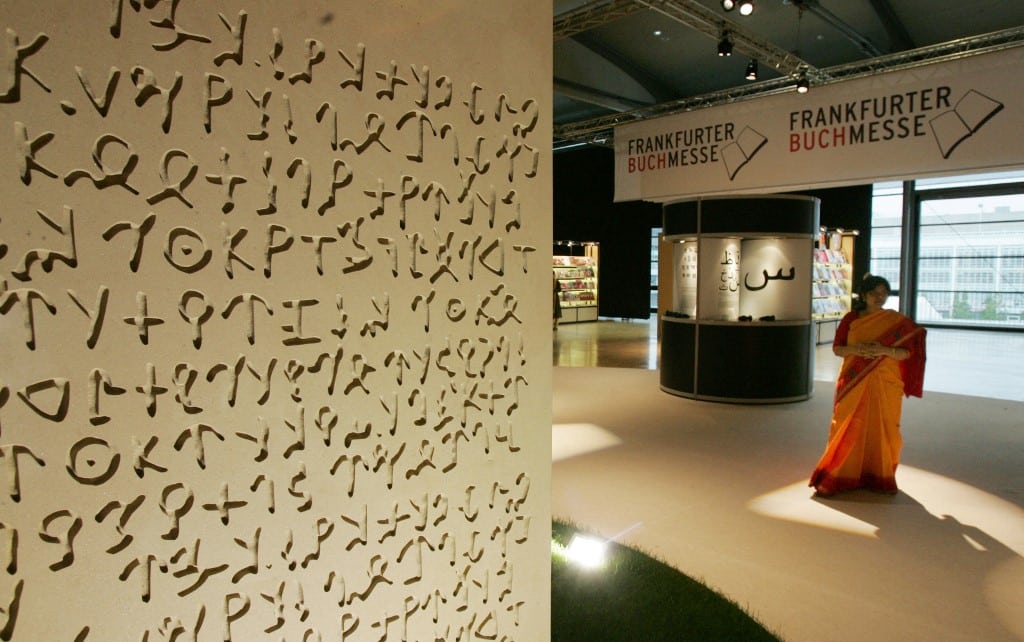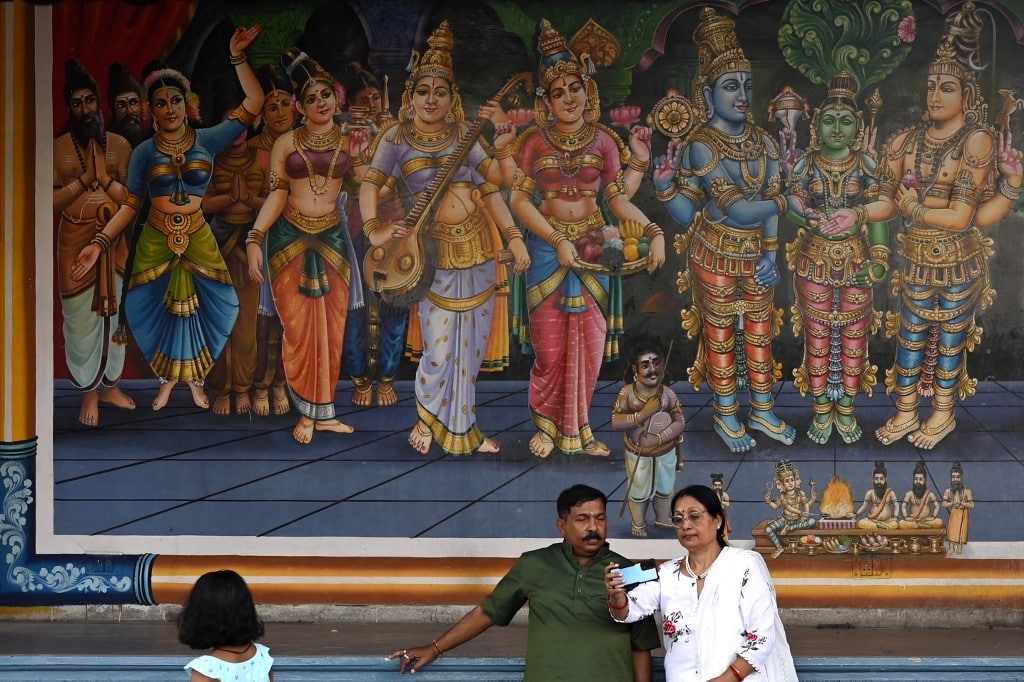
If language distinguishes humans from apes, then the oldest languages in the world are the closest to what we first spoke around two million years ago when humans started to stand upright, their brains grew gigantic, and their hands more nimble.
This was a key milestone in how humans evolved away from apes.
But the oldest languages in the world did not originate anywhere immediately when this happened.
It was only 50,000 years ago that humans developed the most basic of spoken language – fossils of human jaws suggest these early humans were probably only making the sounds of long “a”s.
But a 2013 discovery of Homo naledi, an extinct species of archaic human, showed that communication never stopped at anything.
The Homo naledi, who had brains about one-third the size of a modern human’s, lived around the time the first humans were roaming Africa and had their own practices revolving around funeral rites – they appeared to have carried their deceased to place them in a chamber. This, Dr. Agustín Fuentes of Princeton University argues, would require a language of sorts to help the individuals communicate.
Still, Homo naledi aside, it was only 6,000 years ago that scholars say humans learned to write.
Today, there are more than 7,000 living languages spoken across the globe – with many of the oldest languages in the world among them.
They are survivors. Despite colonisation, wars, famine, and globalisation, they are still used in some way or form today. Some are even thriving.
However, there is a record number of over 900 languages that are dying. How were they killed? Can we save them from going the way of the dodo, West African black rhino, and Javan tiger?
How the oldest languages in the world disappeared
Some languages that are dead and no longer spoken are:
- Coptic (of the Egyptian Christians)
- Ancient Greek
- Biblical Hebrew
- Old Norse
They died for many reasons – chief among them is conquest. When the Roman empire was at its strongest, local languages were eradicated completely, leaving Latin to spread rapidly throughout the empire and become the lingua franca for many nations.
For thousands of years, the ancient language of religion, law, and the secrets of life flourished.
It was so prominent that it eventually influenced Western languages across Europe like French, Spanish and Portuguese.
In the ceremonies of Mass back then, priests would say “Hoc est corpus!” – which is Latin for “This is the body [of] Christ!” Peasants – who were illiterate and didn’t speak Latin – heard “hocus pocus!” the term used whenever someone’s conjuring tricks today.
Another reason languages wither away is thanks to people like many international students: bilinguals.
As we use another language, like English, for school, work and to watch Netflix, our mother tongues are gradually lost to unuse.
When a certain language becomes isolated or used sparsely, it faces the possibility of fading away.
Other factors that led to the death of languages include:
- No or lack of written records or oral traditions to preserve or revive a language
- When humans created the first printers in 1476, this changed the way languages are spoken and words are spelt
- As more people moved abroad, particularly children, their mother tongue was not passed down by older generations
If we are not careful, linguists believe that 90% of languages will become obsolete by the next century.
In fact, one language falls out of use every two weeks – with regions like Northern Australia, Central South America, North America’s upper Pacific coastal zone, Eastern Siberia, Oklahoma and the southwestern US suffering the most.
The reason? All had indigenous people speaking diverse languages in falling numbers.

An arts and crafts dealer explains the virtues of rice paper for writing calligraphy as another vendor sits next to his cart of Chinese trinkets and “antiques” in Liulichang, Beijing’s antique street. Source: AFP
Survival of the fittest: 10 oldest languages in the world
1. Chinese (6,000 years old)
The Chinese language is the oldest written language in the world, having been sighted on animal bones, known as oracle bones, that date back to the Shang dynasty. This means it was some 3,600 years ago when the written language was first used.
The standard spoken form of Chinese, known as Mandarin or Putonghua, is spoken in the northern, central and southwestern provinces of China. It is also spoken by 1.4 billion speakers who use it as their mother tongue.
Funnily enough, language learning app Duolingo reported a 216% increase in new US users learning Mandarin in January 2025 compared to the year prior. It was attributed to TikTok users hopping onto the Chinese social media platform RedNote (aka Xiaohongshu) when the Trump administration was moving to ban the former app.
Whatever your reason for learning Chinese is, know that its rich history and widespread usage have made significant contributions to the world today, including through:
- Literature: Ancient classics from Confucius, Laozi, and Zhuangzi offer profound insights into ethics, governance, and human nature.
- Calligraphy: It is considered a visual art and a good skill to have.

A hostess waits for visitors to view a Sanskrit inscribed slab in Germany. Source: AFP
2. Sanskrit (4,000 years old)
Another one of the oldest languages in the world is Sanskrit, an ancient Indo-Aryan language widely used in Jainism, Buddhism, and Sikhism.
Sanskirt’s effects are seen in poetry, drama, and sciences, as well as religious and philosophical texts. Sacred texts like the “Mahabharata” (of which the Hindu scripture Bhagavad Gita is part of) and “Ramayana” were all written in the language.
The “Upanishad” is another great example of Sanskrit’s influence on the ancient linguistic landscape as it contains religious texts of Hinduism explaining the foundations of the religion.
But that’s not all; Sanskrit’s contribution extends beyond the literary or linguistic realms.
The “Sulbasutras” contain geometric and algebraic principles that have contributed to the advancement of mathematical knowledge and were appendices to the Vedas (a large collection of religious text), which gave specific rules and measurements on how to construct an altar.
It’s a language filled with more history than any can imagine, and it’s why many seek to revitalise its use.
Take the 2020 New Education Policy (NEP) of India, for example — it aims to revamp India’s education system to promote the use of Indian languages, including calling for the integration of Sanskrit language and literature education at all levels.
Later on, in 2022, Google Translate added eight Indian languages, including Sanskrit, to its app. “Sanskrit is the number one, most requested language at Google Translate, and we are finally adding it,” said Isaac Caswell, senior software engineer at Google Research, to the Economic Times.
3. Egyptian (4,000 years old)
The Egyptian language, specifically Ancient Egyptian, originated in the Nile Valley of Northeastern Africa and has had connections to Semitic languages.
The language underwent many variations – Old Egyptian, Middle Egyptian, and Late Egyptian until its last phase, the Coptic alphabet. As the language evolved, it became more widely spoken by the common man as well as the elite for various reasons, including religious ceremonies, legal proceedings, and literature.
The hieroglyphic script, which was used to write the Egyptian language, adorned the walls of temples and tombs, providing insights into religious beliefs, historical events, and daily life in ancient Egypt.
4. Sumerian (3,200 years old)
Sumerian is among the earliest languages for which written evidence exists, with its cuneiform script becoming known to be the greatest contribution from the Sumerian people.
Distinct from the alphabet, cuneiform uses between 600 and 1,000 characters impressed on clay to spell words by dividing them up into syllables.
The language itself was spoken in ancient Mesopotamia (modern-day Iraq) but suffered a decline, with many saying a drought killed off the language with many of its people.
However, the Sumerians left behind extensive written records on clay tablets, providing valuable insights into their culture, history, and language. One such clay tablet found was packed with information, says Professor Nicholas Postgate, a Senior Fellow at the McDonald Institute for Archaeological Research at Cambridge.

Hebrew was spoken in Biblical times, including when Christ lived. Source: AFP
5. Hebrew (3,000 years old)
Hebrew is an ancient Semitic language with roots that date back to biblical times, making it one of the oldest languages in the world.
Historically used by the early Jews for religious purposes, the language was almost completely lost during the Holocaust but experienced a revival in the late 19th century.
Modern Hebrew is now the official language of Israel, and it is taught and spoken by the majority of people living there. Beyond that, the language is spoken widely worldwide due to centuries of Jewish migration and diaspora.
It has found a place among scholars and academics as an important language for studying ancient texts and religious scriptures too – thanks to its unique alphabet and grammatical structure.

People pose for a selfie on the upper deck of a ferry from the port of Piraeus in Athens to the Island of Mykonos, Greece. Source: AFP
6. Greek (3,000 years old)
Spanning over three millennia, the Greek language is one of the oldest languages in the world.
Ancient Greek was developed in the classical era and was the choice of language for mathematicians, philosophers, and playwrights. Later on, Modern Greek became the official language of the Kingdom of Greece in the 19th century.
Today, 13 million people use it as their first language.
Even those who don’t speak Greek are familiar with certain words and stories. “Going on an Odyssey” refers to going on a long and challenging journey; “phobia” comes from Phobos, the Greek god and personification of fear and panic; and “herculean task” refers to something extremely difficult; requiring the strength of the Roman god Hercules (or Heracles, as the Greeks called him).

People shop at the Grand Bazaar in Tehran on May 22, 2023 — where Persian can be heard everywhere you turn. Source: AFP
7. Farsi (3,000 years old)
Farsi, also known as Persian, is an Indo-European language. It originated in Iran and remains the official language, as well as being spoken in neighbouring countries like Afghanistan and Tajikistan.
The language is rich; its literary works have been widely recognised as being one of the four main bodies of world literature where famous and influential poets like Rumi, Nizami, and Daqiqi have left a long-lasting and profound impression on generations.
It is also spoken in many countries worldwide because of its diaspora communities, including a significant minority in Uzbekistan and diaspora communities throughout Israel, Australia, North America, and Europe.
Altogether, an estimated 110 million people globally speak Farsi.

One of the oldest languages in the world, Tamil was used in religious texts. Source: AFP
8. Tamil (2,300 years old)
Tamil is one of the oldest languages in the world, with the origins of the language traced back to the southern part of the Indian subcontinent, where experts have discovered literary works dating back to 350 BC.
With a sophisticated literary tradition spanning over two thousand years and encompassing classical works, modern literature, and poetry, Tamil has had a profound impact on many different areas – including art, culture and academia.
The language was instrumental in shaping and developing the cultural and intellectual landscape, particularly in South India. Its script, consisting of elegant and distinct characters, is used for writing not only in Tamil but also in other Dravidian languages.
In 2004, Tamil was declared a classical language of India upon meeting the three criteria: its origins are ancient, it has an independent tradition, and it possesses a considerable body of ancient literature.
In January 2025, US Congressman Raja Krishnamoorthi even introduced a bipartisan resolution to designate January as Tamil Language and Heritage Month — a resolution that coincided with Pongal, a major Tamil festival that begins in mid-January.

Italian is spoken in 18 countries. Source: AFP
9. Italian (2,100 years old)
Italian, as we know it today, originated from Vulgar Latin. After the fall of the Roman Empire, the colloquial form of the Latin language began forming from various regional dialects.
Tuscan, the dialect widely used in Florence, stood out with its phonetic and grammatical features. Between that and with great literary works by Dante Alighieri, Petrarch, and Boccaccio being written in the dialect, it spread the language across the region, shaping the foundation of what would later become the Italian language.
After undergoing standardisation and codification, the unified national language for the newly formed Kingdom of Italy was established in 1861.
Today, roughly 61.8 million people worldwide speak Italian as their mother tongue. It is also the official language of Italy and San Marino, as well as the co-official language in Switzerland and the Vatican City. and is spoken in 13 other countries.

People wear traditional Hanbok clothing at a culture festival in Seoul on May 19, 2023. Source: Anthony Wallace/AFP
10. Korean (2,100 years old)
Korean is spoken by more than 75 million people today – 48 million living in South Korea and 24 million living in North Korea.
And, not to forget, the many people who learned it because of the Hallyu Wave. US college student enrolment in Korean language classes rose 78% from 2009 to 2016, despite the fact that total enrollment in language classes has plateaued during those years, according to data from Modern Language Association.
The Korean language has unique linguistic characteristics and belongs to the Koreanic language family, which is a language isolate, meaning it does not have any known close relatives, despite wrong assumptions of its relation to Chinese, Japanese, or other neighbouring languages.
The earliest evidence of this language comes from Old Korean inscriptions dating back to the 4th century. This includes the Samguk Yusa, an invaluable record telling the history and legends of Korea’s founding, and the Gwanggaeto Stele, the largest engraved stele in the world describing the main events of the Goruryeo king Gwanggaeto the Great.
11. Arabic (2,000 years old)
Not only is Arabic one of the oldest languages in the world, but it is also one of the most widely spoken. Around 400 million people worldwide are either native or second language speakers of the language.
The language has a history of around 2,000 to 2,500 years. It originates from the Arabian Peninsula, where it was spoken by nomadic tribes. It is a Semitic language, sharing roots with Hebrew and Aramaic, and its early forms date back to at least the 8th century BCE.
The spread and refinement of Arabic came about due to trade, migration, and the Islamic conquests of the 7th century, which carried it across North Africa, the Iberian Peninsula, and into Asia.
Unlike some ancient languages that have died out or changed completely, a significant amount of ancient Arabic literature is still readable today.
Honourable mention
Punjabi (1,024)
With over 100 million speakers worldwide, Punjabi isn’t likely to disappear anytime soon. However, the decline in speakers persists, especially in Pakistan, where the language originated.
Although 44.15% of the country’s population currently speaks Punjabi as their mother tongue, that’s still a noticeable drop from 57.08% in 1951, data from the Pakistan Bureau of Statistics shows.
Like the other oldest languages in the world, there are social, cultural, and political shifts that are causing this decline. Punjabi is not formally recognised as an academic and official language within its own region, for one. It doesn’t have a widely standardised script or alphabet that can accurately reflect its sounds and expressions too.
Then there’s the issue of schools. Few urban schools teach it. Policymakers don’t seem to want to include it in the formal education system anytime soon as well, mainly due to the perception that it holds a lower social status compared to languages like English or Urdu.
Fatima Ebadat Khan, an MS in Education graduate and educator in Pakistan, has seen this firsthand.
“While studying at the University of the Punjab, I was surrounded by brilliant people,” she shares.
“But they were struggling, not because they weren’t capable, but because the programme was in English. They were trying to keep up with an English-medium system, even though Punjabi or Urdu were the only languages they knew.”
Despite Urdu being Pakistan’s official language, it’s not commonly used in daily life by many communities. And while people are learning it, those who aren’t fluent can be excluded, especially when applying for jobs or applying to university.
This puts Punjabi speakers and speakers of other local languages at a significant disadvantage in society.
The language has been in use as a literary language since the 11th century, making it approximately 1,024 years old.
Disclaimer: This article was last updated on November 21, 2025.











